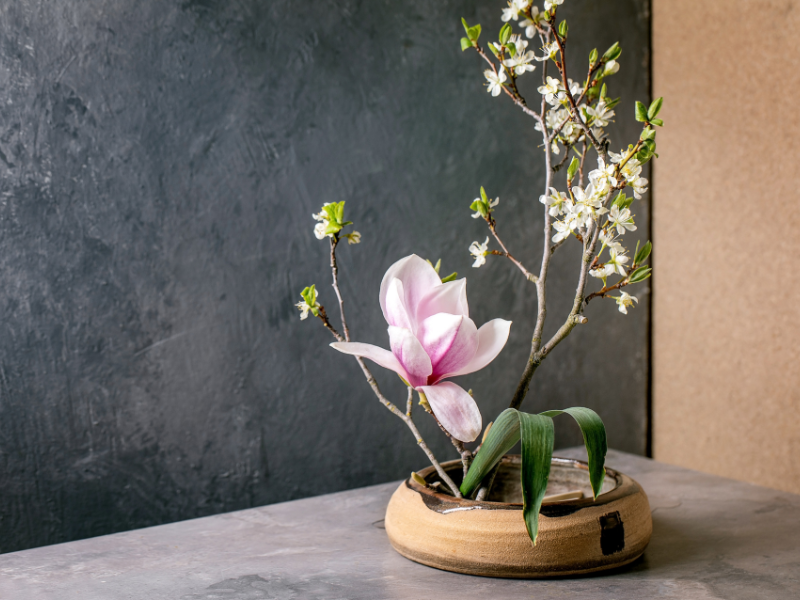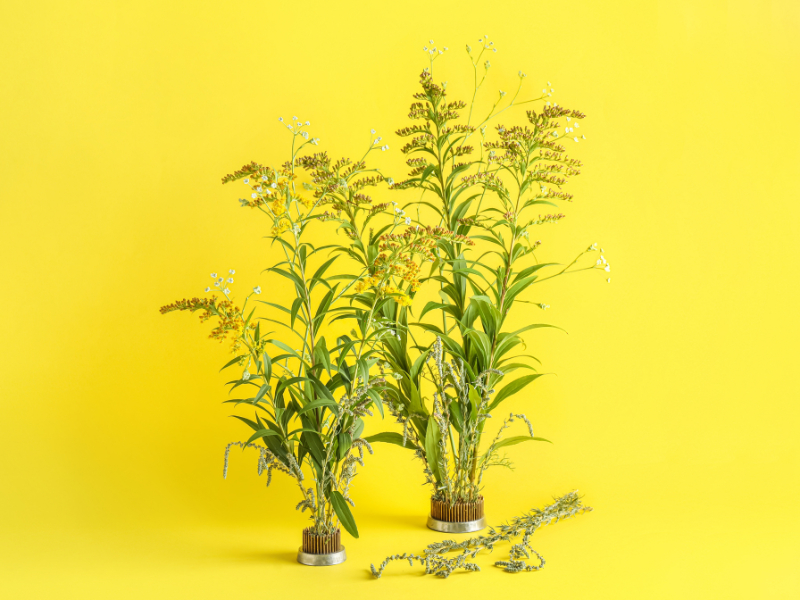For a moment of zen, try creating an Ikebana flower arrangement with freshly cut flowers from your garden or local florist in a beautiful low moribana vase.
Read on to learn how to arrange flowers in the Japanese style of Ikebana.
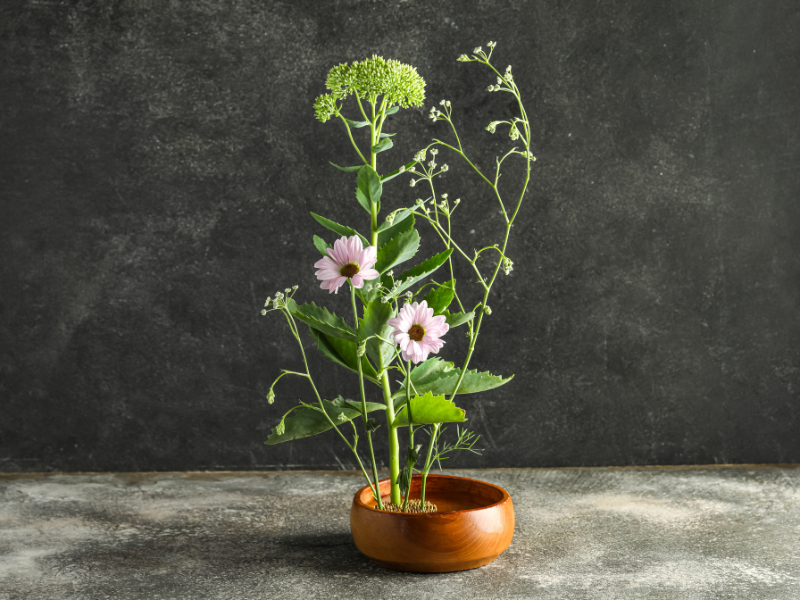
What is Ikebana?
Ikebana is the Japanese art of flower arrangement. It originally came from China via the Buddhist monks who created flower arrangements to decorate altars at shrines and temples. The characters for Ikebana (生け花) translate to living + flower and can be translated to mean “living flower arrangements”. Ikebana flower arrangements use fresh flowers, greenery and other plant materials to create interesting living sculptures that depict the season or moment in time. Ikebana arrangements traditionally were displayed in Japanese homes in the ‘tokonoma’ but can be displayed anyway in the home, in an entryway, or table in the living room.
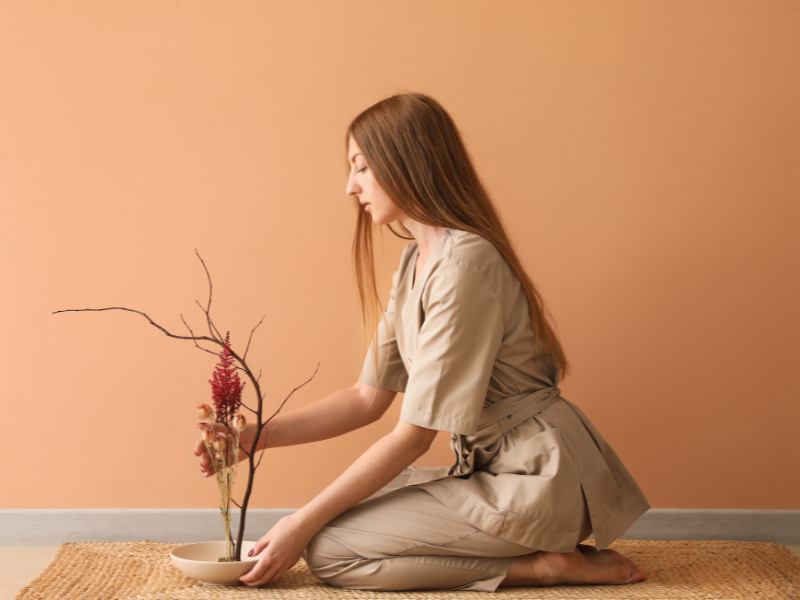
5 Types of Ikebana Arrangements
You can create ikebana flower arrangements in a variety of shapes, sizes, and color schemes. They can be created during any season and with any materials. These are a few common types of ikebana flower arrangements you can draw inspiration from when practicing at home:
- Moribana Arrangement: Use a low vase (or a salad bowl) to create your moribana arrangement. You’ll need to use a kenzan (flower frog) to fix the flowers in place so they stand up tall and securely. Use a limited selection of branches and flowers at different heights and angles to create a sculptural arrangement that emanates calmness. Make sure there is plenty of space and gaps within the arrangement so that each branch and flower can be seen and enjoyed.
- Nageire arrangement: For this arrangement, you use a tall ceramic vase. This is the perfect arrangement to welcome guests at the entrance way and make a statement. First arrange your branches inside the vase, using cross bars or other crossing methods to build a secure base. Then add in your flowers so they are angled to come out elegantly from the vase. Take time to consider the colour of the vase and the colour of the flowers to create a harmonious composition.
- Tsubo Arrangement: To display your branches in the best way possible, and especially blossom branches, use a tsubo vase (a round vase with a thinner opening). The branches can be scissored together to create wide angles in the vase allowing the length and curves of each branch to shine. These arrangements are perfect for a large kitchen counter or reception area. Mix two different types of flowering blossoms to create a vivid display of colour in a unique sculptural design.
- Glass vase arrangement: When arranging using glass vases in ikebana, you need to think differently than you would if you were creating a western arrangement in a glass vase. The display of the inside of the glass vase is just as important as the flowers coming out the top of the vase. Try using tropical flowers and leaves that can last underwater to make an interesting arrangement that incorporates the features of the glass and water in the design.
- Miniature arrangement: Fill tiny bud vases, old perfume or spice bottles with delicate grasses, small wildflowers, or other tiny flowers you find on the footpath to create arrangements that will fit in small spaces of your home like bathrooms, hallways, or in bookshelves. It’s a fun activity to forage for tiny materials to use in your miniature arrangements, that you can collect in your hand on a walk. Display the miniature arrangements in sets of 3, 5 or 7 on top of a tray or mat.
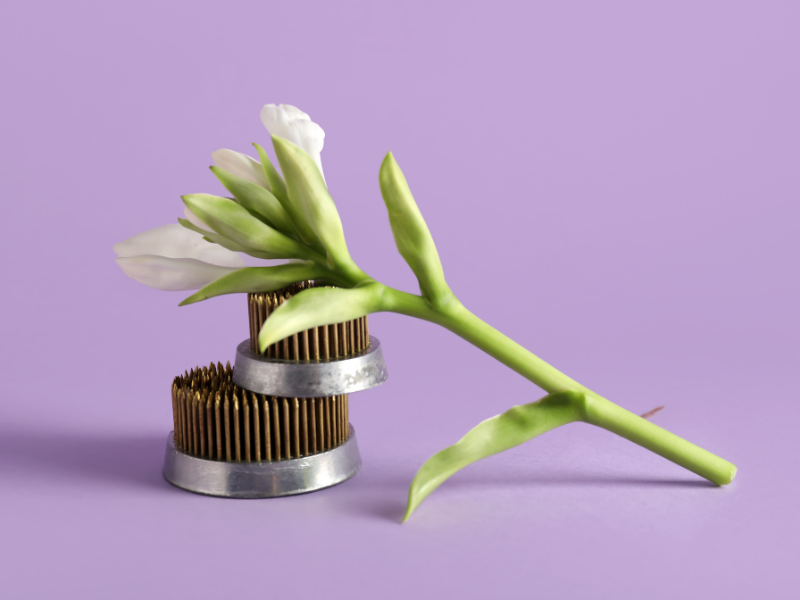
How to Create a Moribana Ikebana Flower Arrangement
Before beginning to create your first ikebana flower arrangement, you may want to first research ikebana and different styles of arrangements. After you’ve decided on a style that you like and seen some inspiration pieces, you can determine the best flowers, branches and vase to use. Once you’ve got all your materials together, use the below steps to create your ikebana arrangement at home:
- Clean your vase. Make sure you start with a clean vase, as this will help your water to stay fresh, and the flowers to live longer.
- Add your kenzan. For a low moribana arrangement, you will need to use your kenzan (flower frog) to secure your branches and flowers in the vase. Make sure your kenzan is positioned in the vase in a location where it is not touching the wall of the vase. You could choose to position it in the center or off-center location depending on the style of arrangement you’d like to make.
- Add water. Fill the vase with water, to just above the height of the kenzan. The water should be clean and appear fresh. As you make the arrangement, be sure to remove any leaves or material that drops into the water whilst you arrange.
- Prepare the branches. Check your branches for dirt or damaged leaves that you need to first remove or clean with water. Measure the length of the branches you’d like to use and then using floral scissors or gardening secateurs, cut to the right heights.
- Arrange the branches. Arrange the branches in your vase, starting from tallest to shortest branch. You should be considering the angles that the branches are making, and ensuring that there is plenty of space surrounding each branch.
- Prepare the flowers. Clean your flowers and make sure, like the branches, that there is no dirt or damaged leaves/petals on your flowers. Measure the length of the flower stems you’d like to use and then using floral scissors, cut your stems under water. Cutting your flower stems under water stops any air bubbles coming up the stems and blocking the flow of water in your flower.
- Add your flowers. Like the branches, arrange your flowers starting from tallest to shortest. You should be careful to arrange the flowers so that the flowers are facing the front and you can enjoy their full beauty. Make sure none of the flowers are at the same height, and all have space around them.
- Add your filler. In a moribana arrangement, you always use a kenzan. It is important that when you are looking at the arrangement, you are not able to see the metal spikes of the kenzan. The flowers and branches should look as though they are magically growing from the vase without any human-made supports. If the flowers are not covering the kenzan, use some leaves as a filler to cover the kenzan so that isn’t visible.
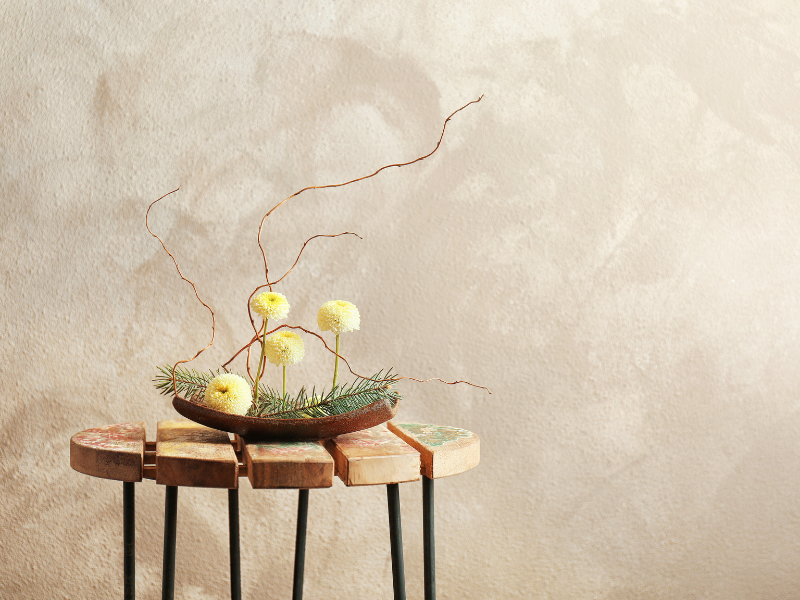
Learn More
Get the Flower Club International Annual Membership for access to our Ikebana study groups to learn more about Ikebana from wherever you are in the world.
